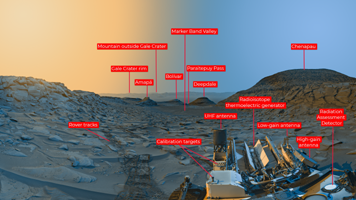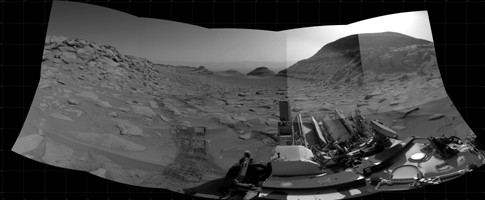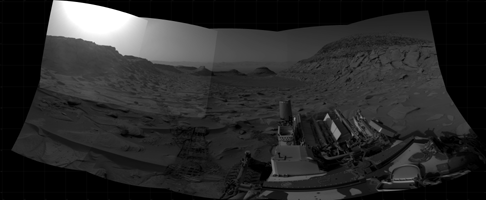Curiosity's 'Postcard' of 'Marker Band Valley'

Figure A

Figure B

Figure C
Click on images for larger versions
NASA's Curiosity Mars rover used its black-and-white navigation cameras to capture panoramas at two times of day on April 8, 2023. The panoramas were captured at 9:20 a.m. and 3:40 p.m. local Mars time, then merged together. Color was added for an artistic interpretation of the scene, with blue representing the morning panorama and yellow representing the afternoon one. The resulting "postcard" is similar to one created with rover images taken in November 2021.
Figure A is an annotated version of the postcard noting geographic features and elements of the rover.
Figure B is the morning panorama without added color; Figure C is the afternoon panorama without added color.
Each of these new panoramas took about 7 1/2 minutes to capture and include five individual images that were stitched together after being sent to Earth. By capturing the panoramas at two different times of day, the scene shows dramatic shadows similar to stage lighting coming in from the left and right of center stage. Additionally, it was winter at Curiosity's location at the time these images were captured; shadows are sharper and deeper during winter, when dust is at its lowest in the Martian atmosphere.
At the bottom right of the postcard is Curiosity. The rover's three antennas and nuclear power source are visible. Trailing behind Curiosity are rover tracks, and beyond those are "Marker Band Valley," a winding region where the rover discovered unexpected signs of an ancient lake. Further below are two hills – "Bolivar" and "Deepdale" – that Curiosity drove between while exploring "Paraitepuy Pass."
Curiosity is ascending the foothills of Mount Sharp, a 3-mile-tall (5-kilometer-tall) mountain found within Gale Crater; the crater rim is visible roughly 25 miles (40 kilometers) away. And because skies were so clear, a mountain beyond the crater rim can be seen, even though it's 54 miles (87 kilometers) outside of Gale.
Curiosity was built by NASA's Jet Propulsion Laboratory, which is managed by Caltech in Pasadena, California. JPL leads the mission on behalf of NASA's Science Mission Directorate in Washington.
